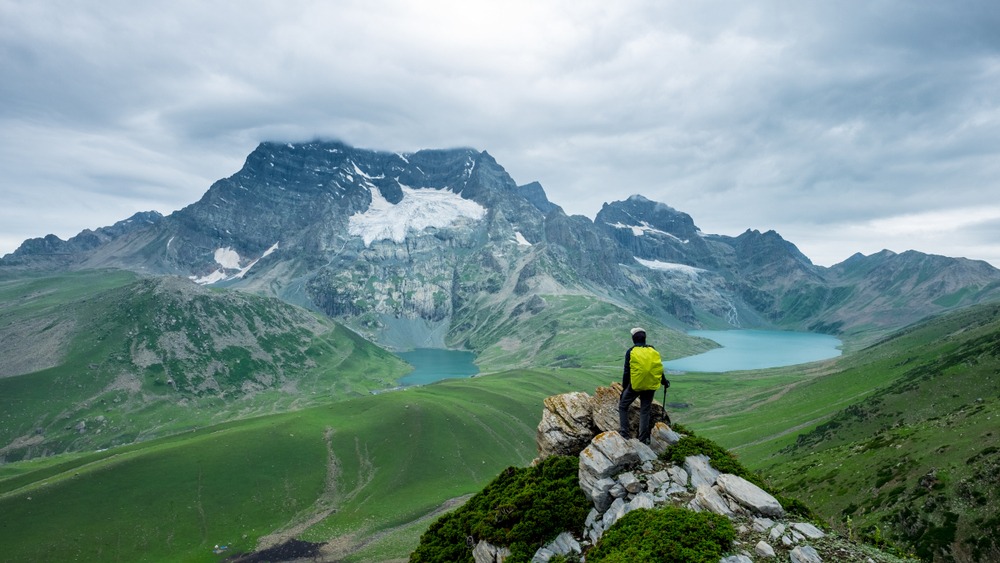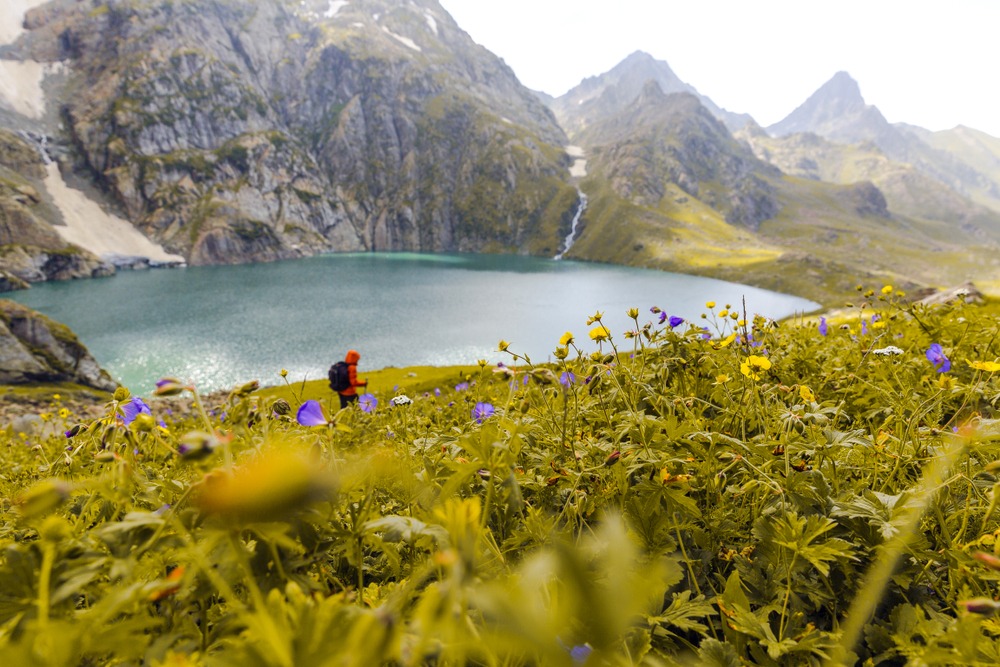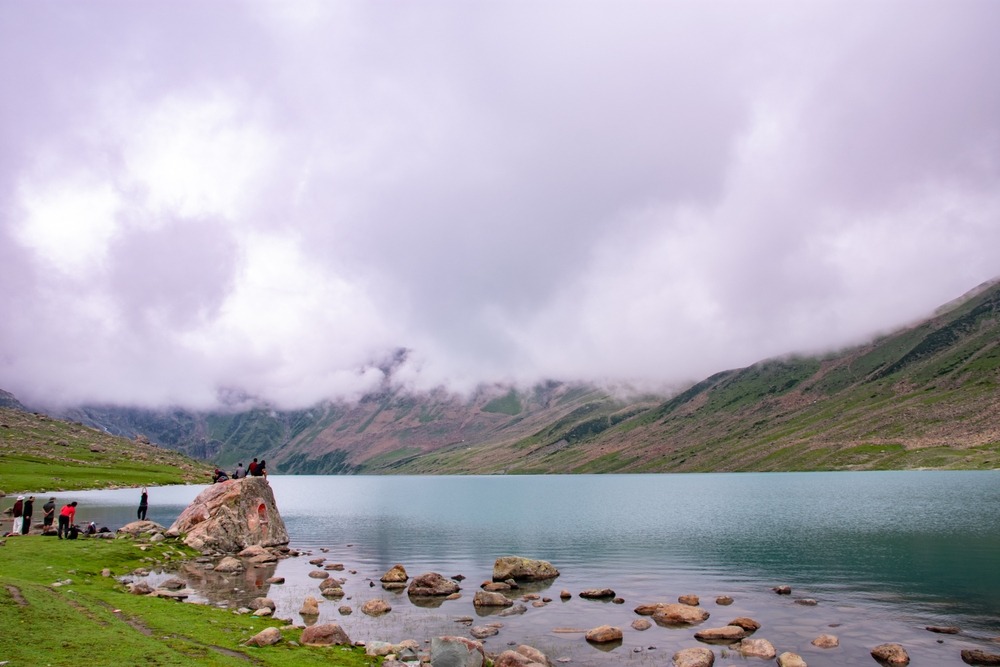Are you ready to join me on a journey through the breathtaking landscapes of Kashmir? Let’s lace up our boots, pack our bags, and dive into the wonders of the Kashmir Great Lakes Trek together.
The Call of the Wild: Overview of the Kashmir Great Lakes Trek
Picture this: lush meadows, crystal-clear lakes, and towering snow-capped peaks as far as the eye can see. That’s the Kashmir Great Lakes Trek for you – a paradise for nature enthusiasts and thrill-seekers alike. Get ready to immerse yourself in seven mesmerizing alpine lakes, each more enchanting than the last.
The journey begins in Srinagar, the heart of the Kashmir Valley. From here, we embark on an adventure that will take us through some of the most stunning landscapes on earth. The trek covers a distance of over 70 kilometers, winding its way through remote villages, dense forests, and high mountain passes.
Embarking on the Adventure of Kashmir Great Lakes Trek: Duration and Itinerary

You may be wondering, “How long will this epic adventure last?” The Kashmir Great Lakes Trek normally lasts 7 to 9 days, depending on your schedule and speed. Let me break it down for you.
Day 1: Setting Off from Srinagar We kick off our adventure with a scenic drive from Srinagar to Sonamarg, where the real journey begins. The drive itself is a feast for the eyes, with panoramic views of lush valleys and snow-capped peaks. Upon reaching Sonamarg, we take our first steps on the trail, trekking to Nichnai, our first stop amidst the stunning wilderness of Kashmir. The trail meanders through meadows adorned with vibrant wildflowers, offering glimpses of the majestic peaks that await us.
Day 2: Into the Heart of Nature As we continue our trek, we’ll traverse through meadows and streams, soaking in the beauty of Vishansar Lake. The trail progressively ascends, offering beautiful views of the surrounding mountains. Vishansar Lake, with its emerald waters reflecting the azure sky, is a sight to behold. We set up camp near the lake, surrounded by nature’s symphony, with the sound of gurgling streams and chirping birds lulling us to sleep.
Day 3: Exploring Hidden Gems Onwards to Gadsar Lake, where we’ll encounter landscapes straight out of a fairy tale. The trail leads us through dense forests and alpine meadows, with the occasional glimpse of grazing sheep or a shepherd’s hut. As we approach Gadsar Lake, the scenery becomes increasingly dramatic, with rugged peaks towering above us. Gadsar Lake itself is a jewel set amidst the mountains, its tranquil waters mirroring the surrounding landscape in perfect symmetry.
Day 4: Finding Solace in Nature’s Embrace As we journey to Satsar Lakes, prepare to be enchanted by the tranquility of nature. The trail meanders through lush meadows and rocky terrain, with the occasional sighting of a marmot or Himalayan ibex. Satsar Lakes, a cluster of seven alpine lakes nestled amidst towering peaks, is our home for the night. As we sit by the campfire, sharing stories under the starlit sky, we can’t help but feel grateful for the beauty that surrounds us.
Day 5: Reaching New Heights Gangbal Lake awaits, nestled amidst towering peaks. The trail ascends steeply, challenging our endurance and determination. But the effort is worth it as we catch our first glimpse of Gangbal Lake, its sapphire waters shimmering in the sunlight. Surrounded by snow-capped peaks, the lake exudes an otherworldly charm, inviting us to linger and soak in its beauty.
Day 6: Homeward Bound As we bid farewell to the mountains, we descend to Naranag and reminisce about the unforgettable moments of our trek. The descent is bittersweet, as we leave behind the majestic peaks and pristine lakes that have become our home over the past week. But as we reach the valley floor, we’re filled with a sense of accomplishment and gratitude for the experiences we’ve shared.
Day 7: Until We Meet Again With hearts full of memories, we bid adieu to Srinagar, knowing that the spirit of the Kashmir Great Lakes Trek will stay with us forever. The journey may be over, but the memories will last a lifetime, reminding us of the beauty and wonder that await us in the great outdoors.
Choosing the Perfect Season: Best Time For Kashmir Great Lakes Trek
Now, let’s talk about timing. The best time to embark on this adventure is from June to September when the weather is just right, and the trails are calling out to us. Picture vibrant wildflowers, clear skies, and comfortable temperatures – sounds like paradise, doesn’t it?
During these months, the weather is relatively stable, with clear skies and mild temperatures during the day. However, it’s essential to be prepared for sudden changes in weather, especially at higher altitudes. While the summer months offer the best weather conditions, the monsoon season brings its own charm, with lush greenery and dramatic cloudscapes adding to the allure of the trek.
For your upcoming Kashmir Great Lakes Trek, I recommend considering “The Searching Souls.” They have a solid reputation for organizing exceptional trekking experiences in the region. Their team of experienced guides ensures safety while providing insightful commentary on the local culture and ecology. Plus, their commitment to responsible tourism aligns with our values of preserving the environment and supporting local communities.
Embracing the Challenge: Difficulty Level
But hold on, is this trek suitable for someone like you? Absolutely! While the Kashmir Great Lakes Trek does require a moderate level of fitness, adventurers of all levels can conquer it with a positive mindset and a sense of adventure.
The trails consist of varying terrain, including rocky paths, steep ascents, and river crossings. However, with proper preparation and determination, anyone can tackle the challenges of the trek. It’s essential to train beforehand, focusing on cardiovascular endurance and leg strength to prepare for the long days of hiking.
Packing for Success: Essential Gear
Now, let’s get down to business – packing. From sturdy hiking boots to a cozy sleeping bag, we’ve got you covered. Don’t forget the sunscreen and snacks – trust me; you’ll thank me later.
Here’s a checklist of essential gear to pack for the Kashmir Great Lakes Trek:
- Hiking boots: Invest in a good pair of waterproof hiking boots with ankle support to tackle the rugged terrain.
- Warm layers: Pack lightweight, moisture-wicking clothing for layering to stay warm in chilly temperatures.
- Waterproof jacket: Be prepared for rain showers with a durable, waterproof jacket to keep you dry.
- Sleeping bag: Choose a lightweight, compact sleeping bag rated for cold temperatures to ensure a comfortable night’s sleep.
- Tent: Bring a reliable, lightweight tent for camping along the trail.
- Sunscreen: Protect your skin from the harsh sun at high altitudes with a high SPF sunscreen.
- First-aid kit: Carry a basic first-aid kit with the necessary supplies to treat minor injuries.
- Snacks and water: Stay fueled and hydrated with energy-rich snacks and plenty of water to keep you going throughout the trek.
Diving into Culture: Cultural Insights

But it’s not just about the landscapes; it’s about the people too. During our trek, we’ll have the chance to interact with the warm and hospitable locals, savoring delicious Kashmiri cuisine and learning about their rich culture and traditions.
The Kashmir Valley is known for its vibrant culture and hospitality. As we trek through remote villages, we’ll have the opportunity to immerse ourselves in the local way of life, interacting with villagers, and learning about their customs and traditions. From sampling traditional Kashmiri dishes to participating in local festivals, every moment is an opportunity to connect with the rich cultural heritage of the region.
Treading Lightly: Environmental Impact
As adventurers, we have a responsibility to protect the places we love. By following Leave No Trace principles and respecting the environment, we can ensure that the beauty of the Kashmir Great Lakes remains untouched for generations to come.
Here are some tips for minimizing your environmental impact during the trek:
- Pack out what you pack in: Carry out all your trash and dispose of it properly in designated waste bins.
- Stay on designated trails: Avoid trampling vegetation by staying on established trails and avoiding shortcuts.
- Respect wildlife: Observe wildlife from a distance and avoid feeding or upsetting them.
- Use eco-friendly products: Choose biodegradable soap and toiletries to minimize pollution of water sources.
- Minimize campfire impact: Use established fire rings for campfires and only burn dead wood found on the ground.
Supporting Local Communities: Local Tourism
And let’s not forget about the impact of our travels. By supporting local guides, porters, and homestays, we’re not just exploring; we’re making a positive difference in the lives of the communities we encounter.
Local tourism plays a vital role in supporting the economy of the Kashmir Valley. By hiring local guides and porters, staying in locally-owned guesthouses, and purchasing souvenirs from local artisans, we can contribute directly to the livelihoods of the communities we visit. In addition to supporting the local economy, interacting with locals provides a deeper cultural experience, enriching our understanding of the region and its people.
The Journey Continues: Conclusion
In conclusion, the Kashmir Great Lakes Trek isn’t just a trek; it’s a journey of a lifetime. So, what are you waiting for? Pack your bags, lace up your boots, and let’s embark on an adventure that will stay with us forever.
FAQs: Your Burning Questions Answered
Q: Can beginners do the Kashmir Great Lakes Trek?
A: Absolutely! While it requires a moderate level of fitness, adventurers of all levels can conquer this trek.
Q: When is the best time to undertake the trek?
A: The best time to trek is from June to September when the weather is pleasant and the trails are accessible.
Q: How many days does the trek usually last?
A: Typically, the trek lasts for 7 to 9 days, depending on the chosen route and pace.
Q: What essential gear should I pack for the trek?
A: Essential gear includes sturdy hiking boots, warm layers, a waterproof jacket, a sleeping bag, sunscreen, snacks, and water.
Q: How can I reduce my environmental effect on the trek?
A: Follow Leave No Trace principles, dispose of waste properly, and respect wildlife and vegetation to minimize your environmental impact.
Also Read About More Topics Like – What to Pack for Your Hampta Pass Trekking Adventure





1 Comment